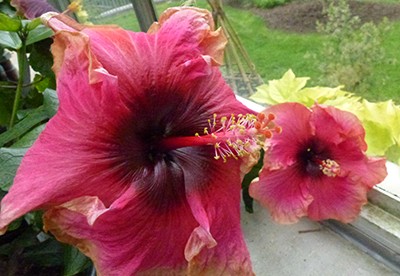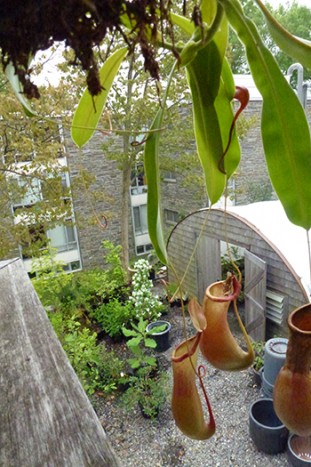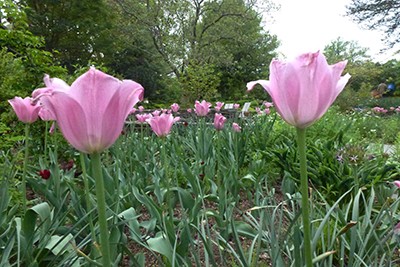Plants of the Week: May 16
I’m quite fond of floral-tastes in candy and drinks; one could say that I’m a connoisseur. Intrigued by the sweet, vaguely cranberry flavor of Hibiscus, I was not disappointed when I discovered that the flowers were as beautiful as they are tasty. While hibiscus tea is made from the calyces of the “Roselle” flowers’ Hibiscus sabdariffa species, my affection for the Hibiscus genus brought me to the Wister Center Greenhouse where I immediately took note of a Hibiscus sinensis ‘Jaime Lou’ in bloom.
A large, evergreen shrub, Hibiscus sinensis ‘Jaime Lou’ originates from Eastern China and usually blooms in summer or autumn, but is capable of blooming year-round, particularly in the ideal conditions of a greenhouse. Aside from ornamentation, the showy dark-pink to peach petals can be used to shine shoes or added to a salad. Whether you intend to eat it, or admire it, Hibiscus sinensis ‘Jaime Lou’ would make a lovely addition to any greenhouse or garden. Photo credit: D. Alvarez
On my first day of work at Scott Arboretum, this Nepenthes was one of the first plants that fascinated me as I walked into the Dave Melrose Headhouse of the Wister Center. Very distinct plants, Nepenthes or “Pitcher Plants’” originate from tropical Southeast Asia and parts of Southern Africa. As many of them are lianas (climbing shrubs), they tend not to have much contact with the nutrient-poor tropical soil. Thus, Nepenthes developed an interesting mechanism to address that survival challenge: they are carnivorous.
Their iconic, pitcher-shaped leaves are colorful, sweet-scented, and deadly to insects foolish enough to get caught in the trap, drowning them in a watery tomb. After the fatal, saccharine mixture dissolves the victims with enzymes, Nepenthes is supplied with much-needed Nitrogen. Nepenthes can produce raceme or panicle blooms, but they can have offensive odors unless removed; the plants are also dioecious, meaning that male flowers must pollinate female flowers in order to produce seed. As Nepenthes is a tropical plant, it likes humidity, warm temperatures, sun, and insects to dine upon, a welcome addition to be hung in pots inside or outside your home to cull the numbers of those pests that you hate. Photo credit: D. Alvarez
Tulipa Queens Mix
A colorful, vast genus of bulbous, perennial, cup-shaped flowers, Tulipa Queens Mix make a lovely addition as a border or container plant in any garden. Originating from the Middle East, they prefer full sun and well-drained soil. The dominant variety seen around Scott Arboretum produces pretty, fuchsia flowers that usually bloom towards the end of March to mid-May. As you can see in the picture, they are easily spotted and make a vibrant contribution to the Entrance Garden of the Cunningham House. Photo credit: D. Alvarez








No Comments